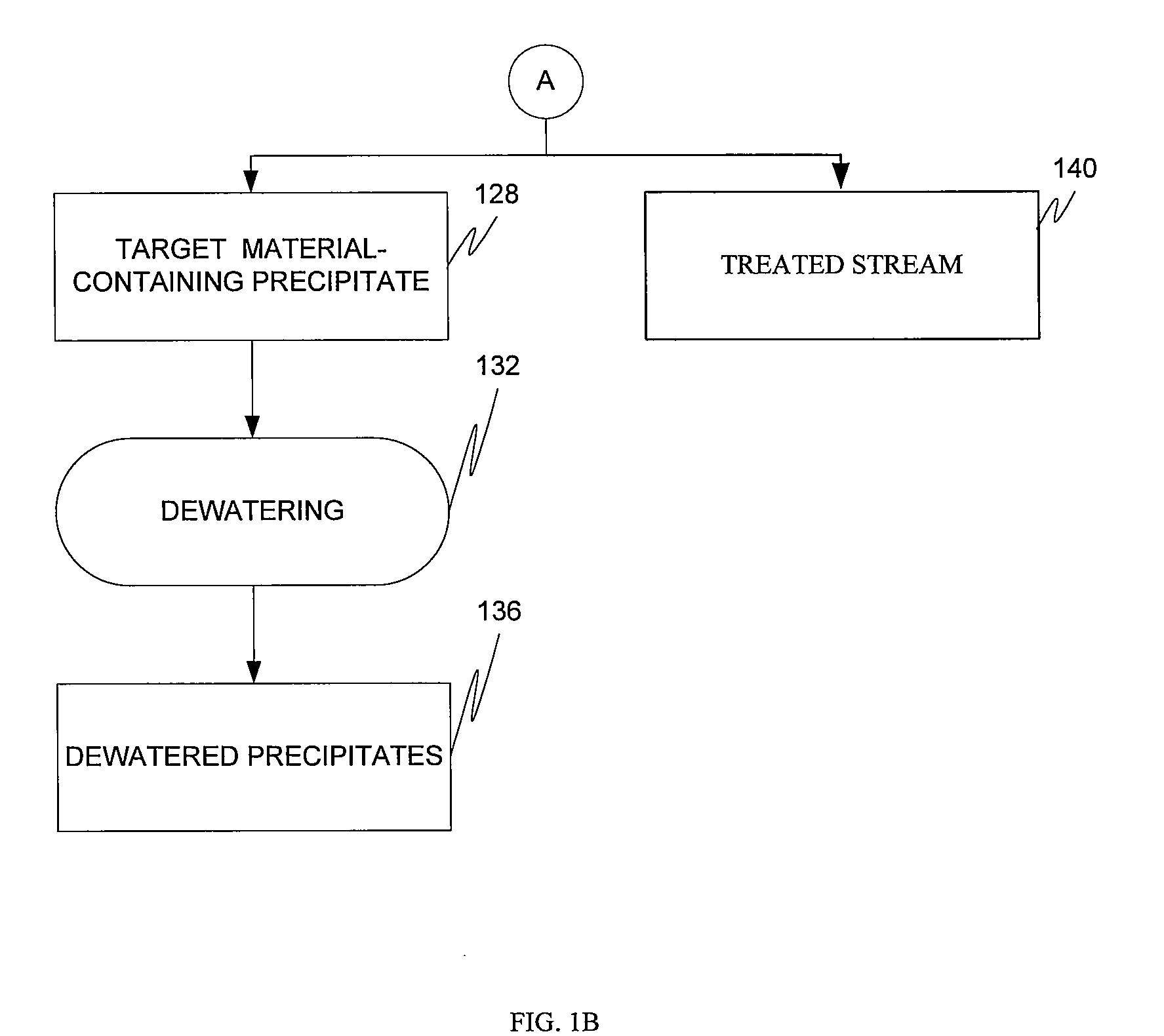Target material removal using rare earth metals
- Summary
- Abstract
- Description
- Claims
- Application Information
AI Technical Summary
Benefits of technology
Problems solved by technology
Method used
Image
Examples
example 1
[0144]A set of tests were conducted to determine a maximum arsenic loading capacity of soluble cerium (III) chloride CeCl3 in an arsenic-containing stream 108 to reduce the arsenic concentration to less than 50 ppm. As shown by Table 1, the arsenic-containing streams 108 (hereinafter alkaline leach solutions) tested had the following compositions:
TABLE 1VolumeTestof DINa2CO3Na2SO4Na2HAsO4—7H2ONumber(mL)(g)(g)(g)As g / L1500108.8751.0410.52500108.8752.08213500108.8754.16424500108.8756.24735500108.8758.32946500108.87510.41157500108.87512.4936
[0145]The initial pH of the seven alkaline leach solutions was approximately pH 11, the temperatures of the solutions were approximately 70 to 80° C., and the reaction times were approximately 30 minutes.
[0146]Seven alkaline leach solutions were made with varying arsenic (V) concentrations, which can be seen in Table 1 above. Each solution contained the same amount of sodium carbonate (20 g / L) and sodium sulfate (17.75 g / L). In a first series of tes...
example 2
[0153]In another experiment, 40 grams of cerium (IV) dioxide particles were loaded into a 1-inch column giving a bed volume of approximately 50 ml. The cerium dioxide bed had an arsenic-containing process stream [75% As(V), 25% As (III)] flowed through the bed and successfully loaded the media with approximately 44 mg of arsenic per gram CeO2 or with approximately 1,700 mg of arsenic total added to the column. Following this, the arsenic loaded cerium dioxide bed had the equivalent of six bed volumes of 5% NaOH solution passed through the bed, at a flow rate of 2 mL / min. This solution released approximately 80% of the 44 mg of arsenic per gram CeO2. Subsequently, the same cerium media was then treated again with the arsenic contaminated process stream [75% As(V), 25% As(III)], loading the media with another 25 mg of arsenic per gram CeO2 or with another 1,000 mg of arsenic. This experiment demonstrates how to regenerate, and thereby prolong the life of, the insoluble fixing agent an...
example 3
[0154]A test was performed to remove residual rare earth fixing agents from an alkaline leach solution.
[0155]Fifteen grams of table salt (NaCl) were added to 150 mL of alkaline leach solution that contained residual cerium from cerium nitrate addition. Table 6 shows the beginning (control) and post-salt concentrations in the alkaline leach solution:
TABLE 3AsCeSample(ppm)(ppm)Control2204700Salt Addition250270
[0156]As can be seen from this Table 3, 94% of the residual cerium has been removed.
PUM
| Property | Measurement | Unit |
|---|---|---|
| Acidity | aaaaa | aaaaa |
| Acidity | aaaaa | aaaaa |
| Acidity | aaaaa | aaaaa |
Abstract
Description
Claims
Application Information
 Login to View More
Login to View More - R&D
- Intellectual Property
- Life Sciences
- Materials
- Tech Scout
- Unparalleled Data Quality
- Higher Quality Content
- 60% Fewer Hallucinations
Browse by: Latest US Patents, China's latest patents, Technical Efficacy Thesaurus, Application Domain, Technology Topic, Popular Technical Reports.
© 2025 PatSnap. All rights reserved.Legal|Privacy policy|Modern Slavery Act Transparency Statement|Sitemap|About US| Contact US: help@patsnap.com



